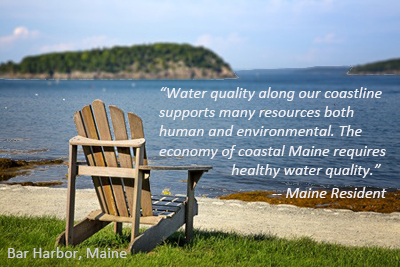 We employed a two-stage strategy in administering the survey. Stage one was the implementation of a mixed-mode pilot survey, where participants were contacted by mail and invited to complete an online survey. The pilot survey contacted a total of 6000 coastal residents; 3960 Maine residents were contacted and 2040 New Hampshire residents were contacted in January 2015. The survey design included two distinct surveys: one focused on citizen use of beaches and the other focused on shellfish consumption, as both resources are dependent upon coastal water quality. Thus our pilot survey invited 1980 Maine residents to answer the Beaches version of the survey and another 1980 Maine residents to answer the Shellfish version of the survey. In New Hampshire, 1020 residents received the Beaches survey, while another 1020 NH residents received the Shellfish survey. We received 509 useable online survey responses (711 undeliverable) for a 10.0% response rate. The information analyzed from the online pilot survey served to pre-test and inform the design of the mail version of the survey.
We employed a two-stage strategy in administering the survey. Stage one was the implementation of a mixed-mode pilot survey, where participants were contacted by mail and invited to complete an online survey. The pilot survey contacted a total of 6000 coastal residents; 3960 Maine residents were contacted and 2040 New Hampshire residents were contacted in January 2015. The survey design included two distinct surveys: one focused on citizen use of beaches and the other focused on shellfish consumption, as both resources are dependent upon coastal water quality. Thus our pilot survey invited 1980 Maine residents to answer the Beaches version of the survey and another 1980 Maine residents to answer the Shellfish version of the survey. In New Hampshire, 1020 residents received the Beaches survey, while another 1020 NH residents received the Shellfish survey. We received 509 useable online survey responses (711 undeliverable) for a 10.0% response rate. The information analyzed from the online pilot survey served to pre-test and inform the design of the mail version of the survey.
Stage two of our survey implementation was the design and administration of a Maine and New Hampshire Coastal Resident Survey mailed to coastal zone residents in August 2015. The sample of 2666 Maine residents was split, half (n=1333) received a Maine Beaches version of the survey, while the other half (n=1333) received the Maine Shellfish version of the survey. Correspondingly, of the 1334 New Hampshire residents in the sample, half (n=667) received a NH Beaches version of the survey, while the other half (n=667) received the NH Shellfish version of the survey. A total of 4000 invitations were mailed to Maine and New Hampshire residents living on the coast and we received 1766 useable survey responses (427 undeliverable) for a 32.9% response rate. The Frenchman Bay (N=42) and Wells (N=68) regions of Maine, as well as the Great Bay (N=40) region in NH were oversampled. The NEST Safe Beaches and Shellfish Project designated these regions as reference sites for biophysical research.
We analyzed the survey response data with SAS 9.4 (SAS Institute Inc., 2013). Our inferential statistics included chi-square tests of distribution differences, t-tests, and analysis of variance (hereafter ANOVA). The age and gender comparison statistics using 2010 U.S. Census data were calculated in Microsoft Excel. A full discussion of the survey methods, analysis, responses, and findings are available from the Pilot Survey Response Report, Pilot Survey Technical Report, and the Maine and New Hampshire Coastal Resident Survey Technical Report.